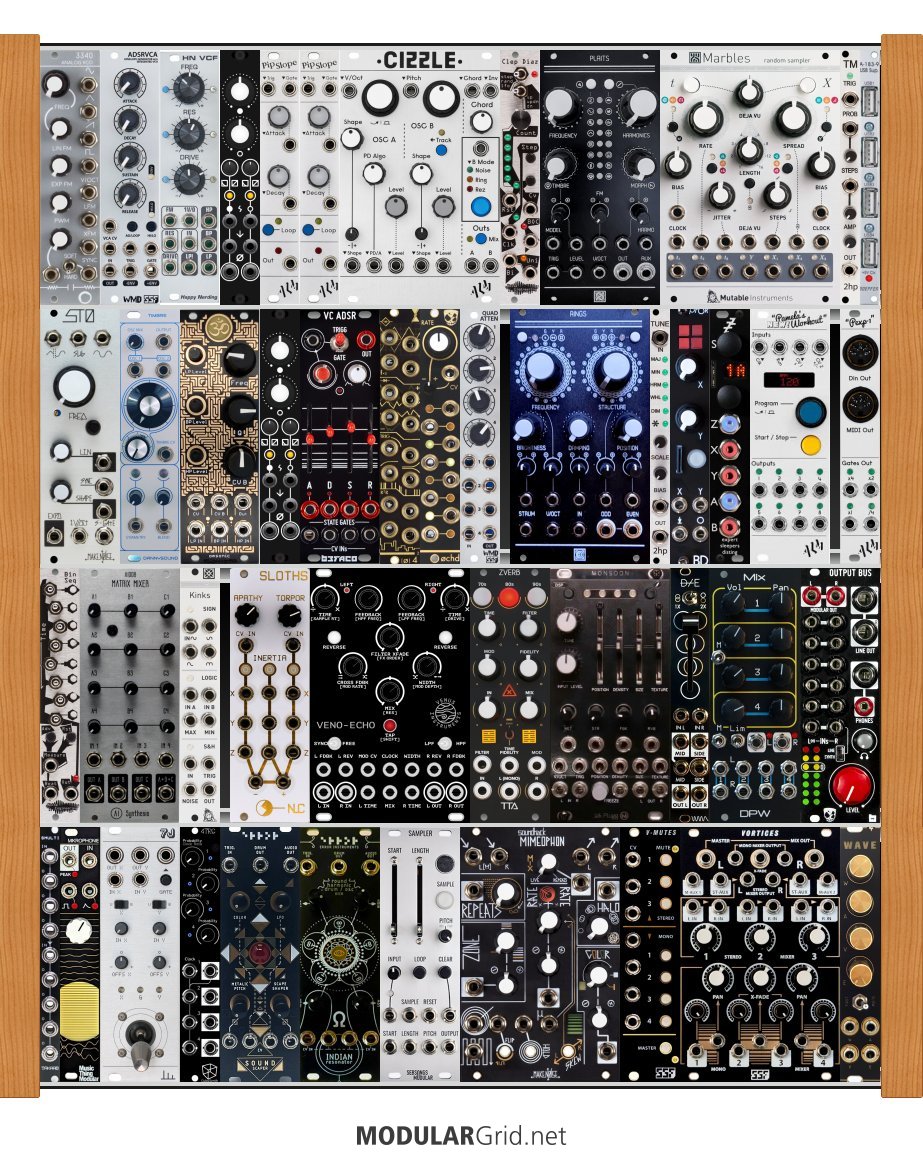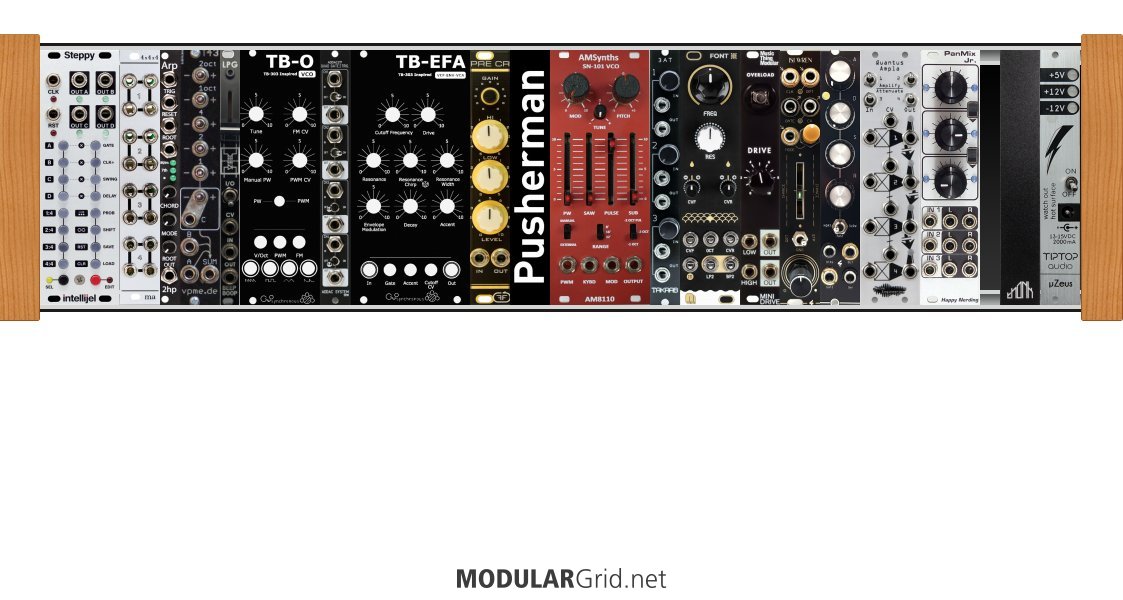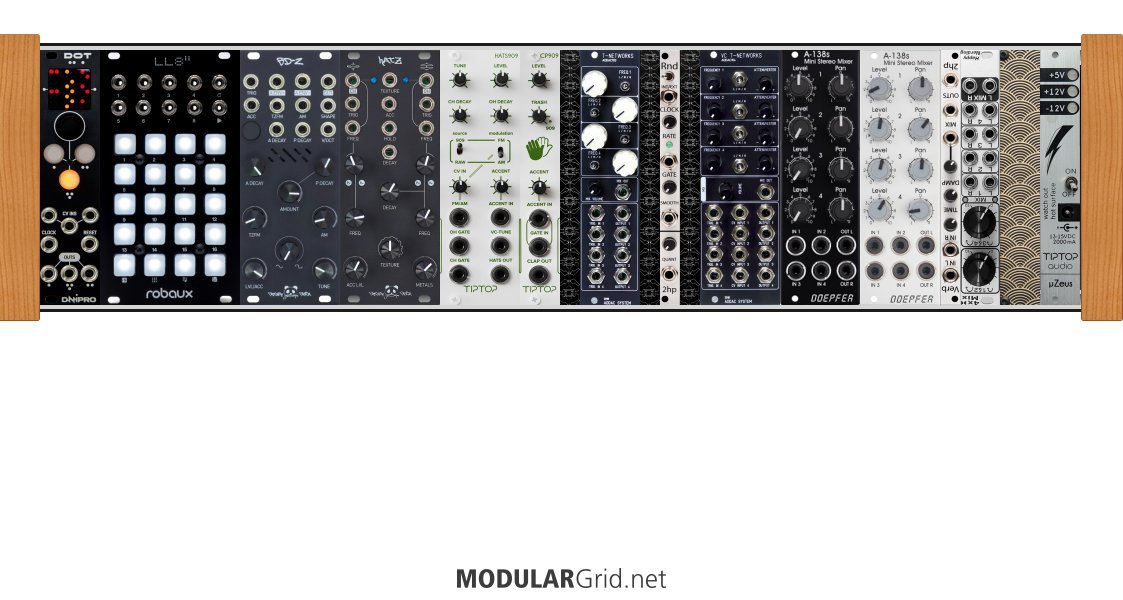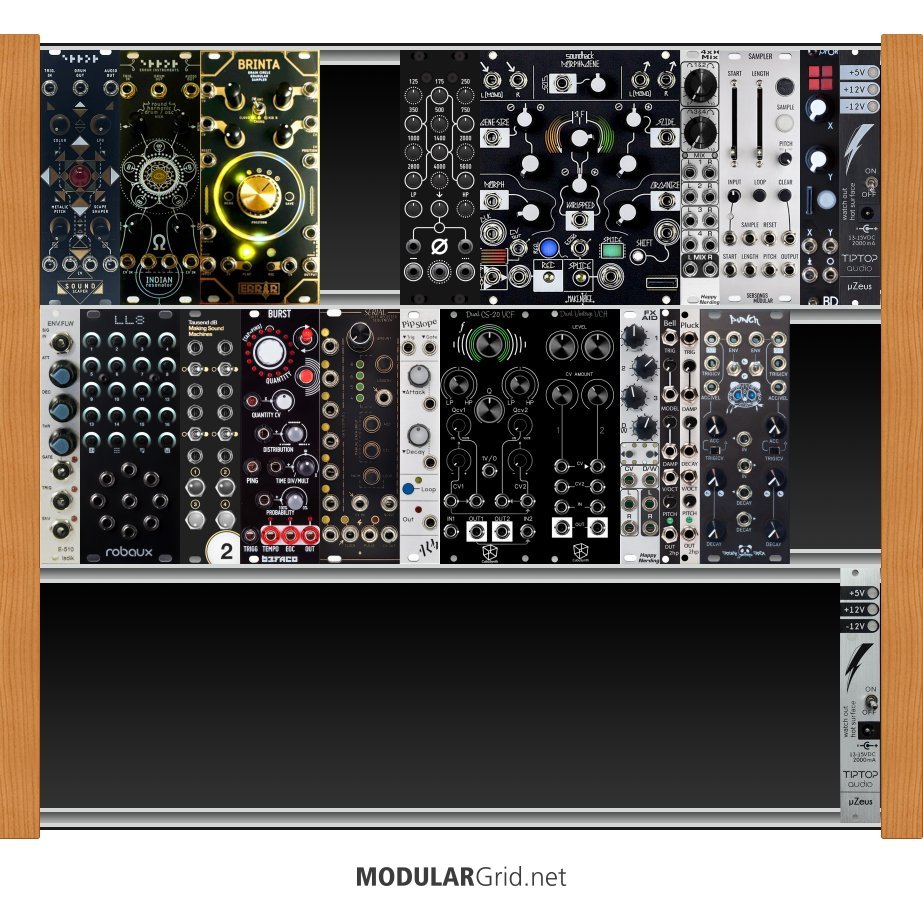maybe leave your rack aside and just get a oneroi desktop.
Greetings
Chris
maybe leave your rack aside and just get a oneroi desktop.
Greetings
Chris
have had a break from music making the last year.
really like the videos i have seen about Befaco Oneiroi,i make Ambient style music,thinking about selling the E352 but as the Oneiroi is a Instrument in its own would it make any sense/benefit my system?
this is what i have now
https://broken-form.bandcamp.com/
Got a Mantis Case for sale,PM Me
I composed a song this weekend using a mix of analog and digital synthesizers.
I enjoyed the combo of Lyra-8 + Collide-4 for bass and a gnarly kick and a newly released sample library for Kontakt featuring the Hardanger fiddle and a mouth harp. I also sprinkled a little harmonious backup using the Equator2 and Solar 42f on top as well.
Hope you enjoy ^_^
I've tried the link to the web page, however on multiple browsers I get warnings about a comprimized website and cant connect to any of the pages.
hey Paolo here, can you contact me via mail? It seems that I need to pay Modulargrid to send you more than 3 emails per day :( thanks
-- rafelino
If you use the service of a person's work, you should be happy to compensate them for it. Especially when it is an inexpensive service that is intended to help you with your expensive hobby.
over:under
Hey folks! Here’s a small patch I put together to test the Echo Crumble effect on the ALM MFX. The idea was to recreate a gritty industrial atmosphere with harsh noise layers, using a heavily detuned Manis Iteritas paired with the Basimilus Iteritas Alter, which provides both rich timbres and punchy drums.
The rhythm is loose and frantic — not really going anywhere on purpose — just pushing forward this little industrial melody that reminds me of glitchy old video game menus.
The Cursus Iteritas handles thick, dark drones, while the ALM MCO adds harmonic character to the Cosmix AUX input, shaped further with a vocoder. The Monotropa boosts everything into a noisy, distorted mess.
Krach delivers a noise-driven rhythmic layer.
Confundo Funkitus is full of gated feedback coming from Integra Solum, simulating a kind of self-generating Krell-style loop.
It’s not the most complex patch I’ve made, but I really like the raw, saturated textures — even if they sometimes push too hard in the lows.
Thanks for listening!
⸻
Gear List
(Modules featured or modulating key parts of the patch):
• ALM Busy Circuits: MFX, MCO, Pamela’s PRO Workout, Axon-2, PPEXP1
• Noise Engineering: Basimilus Iteritas Alter, Manis Iteritas, Cursus Iteritas, Numeric Repetitor, Zularic Repetitor, Integra Solum, Confundo Funkitus, Muta Jovis, Lapsus Os (Black + Silver)
• WMD: Kraken, MSCL
• Cosmotronic: Cosmix
• Ritual Electronics: Krach
• Reverse Landfill: Monotropa v3
• Xaoc Devices: Batumi
• Malekko Heavy Industry: Quad Envelope
• Intellijel: Quadratt 1U, SVF 1U, Dual VCA 1U, Gliss 1U, Buff Mult
• Doepfer: A-180-2 Multiples
• Herzlich Labs: 4x4 Matrix Switch
⸻
[
]A year has passed, and guess what? My system is now twice as big. 28 modules on 168 hp — yes, it's crammed! Still, I like it, and I hope you have some kind words for me.
Just bought a Module from @Ajeistir
Shipping from France to Germany was fast and without problems, module in perfect shape.
Has anyone here purchased anything from user @pdfstudios? He’s based in Berlin and responded quickly to my initial enquiry about the Mega-Tang module. I sent payment the following morning, but since then—radio silence. No tracking info, and no response to any follow-up messages.
The fact that the module is still listed for sale is a bit worrying. I really hope it’s not a scam and that others aren’t also sending him money.
I can see from Instagram that he records/performs under the name perfect_deleted_futures, so maybe he’s just tied up with other things—but I’d be curious to know if anyone else here has dealt with him?
-- sweevo
Just an update on my experience with @pdfstudios. I reached out to one of the people who voted him down and they responded to say they had the same expereince with him. They sent several emails after sending him money and he has never replied. It is confirmed - @pdfstudios is a total scammer and to be avoided. This is the email address he uses on PP: perfectdeletedfutures@gmail.com and his name is caleb salgado. As previously mentioned, he is Berlin based so I'll be contacting the police in Berlin to report online fraud.
Has anyone here purchased anything from user @pdfstudios? He’s based in Berlin and responded quickly to my initial enquiry about the Mega-Tang module. I sent payment the following morning, but since then—radio silence. No tracking info, and no response to any follow-up messages.
The fact that the module is still listed for sale is a bit worrying. I really hope it’s not a scam and that others aren’t also sending him money.
I can see from Instagram that he records/performs under the name perfect_deleted_futures, so maybe he’s just tied up with other things—but I’d be curious to know if anyone else here has dealt with him?
No idea, why no one else as done it. It's a great filter. This uses some CA3080 chips, which aren't cheap, but in production. I'm sure it could be re-designed with more common OTAs.
When adding to rack, Dual Discrete VCA by KOMA Elektronik adds the alternate panel art regardless of which version is selected. This problem has existed for a long time.
I’m still having a lot of trouble with external pitch tracking.
the Hector it doesn't track pitch very well. The pitch tracking is so off that I can't use it unless I use CV from inside Hector.
Even after calibrating Hector using an Ornament and Crime, it won’t play in tune when receiving external CV. Notes are noticeably off, even within a single octave. I’ve confirmed that the CV signal from my Bloom sequencer is accurate—other oscillators in my system track perfectly—but Hector does not track properly unless I route the signal through a quantizer.
While that workaround helps, it uses additional CPU, which I’d prefer to avoid. Pitch tracking seems fine when patching internally within Hector—it’s only with external CV that I’m having this issue.
also, when you output pitch from a quantizer app, the destination synth does not patch.
just for simplicities sake, if i take an lfo, feed it into a quantizer(everything internally in Hector), then output the quantizer to output 1 then patch output 1 into an external oscillator it will always be out of tune.
i have emailed poly effects and they have not been helpful whatsoever. I am not buying a poly effects anything in the future because there was little support. I watched the videos and I still don't understand.
"You'll need to run into the pitch cal modules first for external pitch CV. This is because we use the same inputs for CV and audio, so we can't calibrate them by default as it would distort the audio. So you need to run into pitch cal and then get your fixed up pitch from that. There's instructions in the video series where I talk about those modules."
I have done this and it works for external pitch cv coming in but i have to calibrate it literally every time i turn it on and i dont know how to send pitch cv out of it. its not very useful if i cant output pitch cv or play it without having to calibrate it again.
is there any way to get accurate pitch cv coming out of it to sequence an external module?
Debuting a video for the first track off my EP that drops Friday. 6 minutes long:
Hi all,
does anyone have a good source for obtaining male IDC connectors (2x5 and 2x8), female headers for fastening to ribbons, and ribbon cable-the standard 28 AWG and 2.54mm pitch?
I've bought some off eBay in the past but am looking for something without the high mark up. I've tried Mouser, Digikey, and Tayda but don't have much experience sourcing parts and the search leaves a bit to be desired if you aren't already set with the proper names/specs required.
Thanks!
Checking out Servo, a unique new module from ADDAC Systems. It can turn knobs or trim pots on a modular, synth, pedal, mixer, or anything else that’s small and cylindrical and that lacks a cv input! Perfect for when your hands are busy doing other things, or when you want slow LFO-style modulation, or super-precise stepped adjustments.
I'm using it here to control the envelope decay of a Moog Subharmonicon. I'd be interested to hear what others might use it for.
Looks pretty good. I just want to mention these two things in favour of affordability:
There are cheaper and just as good (or better?) options for Maths. Like Nano Arc ( https://modulargrid.net/e/nano-modules-arc ) and others.
Mutable Instruments modules have been cloned many times by different producers. Opting for clones can save you a lot of money.
Drift Boss is an engaging and addictive mobile game that captures the thrill of drifting in a simple yet captivating way. Players take control of a car navigating a series of winding roads suspended in mid-air, where precision and timing are crucial. The gameplay involves tapping to accelerate and allowing the car to drift around sharp turns while avoiding falls into the abyss. As players progress through increasingly challenging levels, they can collect coins to unlock new vehicles and upgrades, enhancing their drifting experience. The minimalist graphics add a charming aesthetic, making it visually appealing while keeping the focus on the fast-paced action. The game's mechanics are easy to learn, making it accessible for players of all ages, yet the increasing difficulty ensures that it remains a challenge even for seasoned gamers. With its intuitive controls and satisfying gameplay loop, Drift Boss offers a delightful escape that encourages players to improve their skills and achieve higher scores. Whether you're looking for a quick gaming session or a longer playthrough, Drift Boss delivers an exhilarating experience full of twists, turns, and competitive fun, perfect for anyone looking to master the art of drifting.
I agree, definitely onto something there. One note, Quadrax self-attenuates.
2 Hp trim may not be the attenuation you want. Something a little bit more like a 3xMIA could fit into this setup and add additional fleixbility with mixing, inverting, as well as attenuation.
You're def looking in the right directions, though, this would be a versatile setup for the money.
Also, uPlaits, uClouds, and uRings are available that take up less space, in case you wanted to sacrifice a bit of ergonomic value in exchange for HP.
Best wishes and luck!! :)
“You must have chaos within you to give birth to a dancing star.”
― Friedrich Nietzsche
Thank you very much, it was made with a more intuitive workflow in mind.
Looks like you have a pretty good plan in place, don't forget to check ebay etc, its definietly a buyers market out there at the moment so deals to be had, you could look at a Ornament & Crime for Quantization as you get 4x for the money plus a lot of other things to play with.
Enjoy your spare HP, don't rush to fill every last space, this is not like filling sticker books. Resist the urge to 'complete' your rack, its never complete so just relax.
Month 0 (Initial ~£600)
Goal: Have a complete single-voice patch (sound → filter → VCA → trim) with envelope/LFO shaping so you can actually make and sculpt tones—even before you add sequencers or effects.
Module Est. GBP
Mutable Instruments Plaits £150
Make Noise Maths £200
Doepfer A-135-2 Quad VCA / VC Mixer £120
Doepfer A-106-5 SEM VCF £80
2 hp Trim (passive attenuator) £15
Subtotal £565
Plaits → your main sound source (virtual-analog, FM, noise, etc.)
Maths → dual envelope + LFO + slew + attenuverting mixer
Quad VCA → shapes amplitude and acts as mixer
SEM filter → smooth, musical low-pass filtering
2 hp Trim → manual level/CV control and output attenuation
You can patch: Plaits → SEM → Quad VCA → 2 hp Trim → Focusrite. Use Maths for envelopes and slow LFO modulations.
Month 1 (~£400)
Goal: Add clocking, randomness, and a basic S&H for generative tweaks—plus a proper output module for safe line-level and headphone out.
Module Est. GBP
Befaco Output v2 (line + headphone out) £80
Doepfer A-118-1 Noise/Random £75
Synthrotek MST VC LFO £70
Doepfer A-161 Clock Sequencer £60
Doepfer A-160-1 Clock Divider £45
Doepfer A-148 Dual Sample & Hold £60
Subtotal £390
Befaco Out → clean 1/4″ outputs + headphone jack
Noise + S&H → rudimentary random CV
MST VC LFO → dedicated freely swept LFO
Clock Seq + Divider → triggers & sub-divisions for envelopes/LFOs/S&H
Now you’ve got generative sources (random CV, sequenced gates, LFOs) and can patch plaits on autopilot.
Month 2 (~£400)
Goal: Introduce logic branching, pitch quantization, a second filter voice, and switching for evolving patterns.
Module Est. GBP
Doepfer A-166 Dual Logic £90
Sonic Potions Penrose Quantizer £160
Doepfer A-151 Sequential Switch (4-step) £50
Doepfer A-124 SE Wasp Filter (Special) £80
Subtotal £380
Logic → combine/divide gates and clocks for complex rhythms
Penrose → map random voltages to musical pitches
Sequential Switch → cycle CV or audio destinations step-by-step
Wasp Filter → gritty multimode for contrast and second-voice timbral variety
At this point you’ll be running multi-stage generative patches: alternating filters, logic-driven gates, quantized melodies—into Maths-driven envelopes and VCAs.
Month 3 (~£400)
Goal: Add lush ambient texture via granular processing and a second quantizer for more pitch flexibility.
Module Est. GBP
Mutable Instruments Clouds £190
Doepfer A-156 Dual Quantizer £160
Subtotal £350
Clouds → classic granular/reverb-style texture synthesizer
Dual Quantizer → let you quantize two independent CV sources (e.g. one for Plaits, one for Wasp)
Your patches can now flow into Clouds for smearing/delay and maintain harmonic coherence across multiple CV streams.
Month 4 (~£400)
Goal: Deepen modulation routing with a quad function generator and cover any utility gap with a multifunction module.
Module Est. GBP
Intellijel Quadrax £220
Expert Sleepers Disting Mk4 £170
Subtotal £390
Quadrax → four envelopes/LFOs/ADSRs + CV matrix for branching
Disting → dozens of “fill-in” apps (clock dividers, extra S&H, oscillator, logic, offsets, delays…)
With Quadrax you’ll have truly polyphonic modulation, and Disting can stand in whenever you discover a missing utility.
Month 5 (~£400)
Goal: Bring in a second resonator/voice for interplay and final touches.
Module Est. GBP
Mutable Instruments Rings £200
(Leftover budget for cables, adapters, or a small utility/module of your choice) £200
Subtotal
Oh thanks, that’s cool! Yeah, the mix and mastering aren’t always perfect — I definitely need to work on that side of things.
Hi everyone — here’s a short live performance built around these two racks, focused on raw industrial techno textures and modular-driven sequencing.
🎛 Gear Used:
▫ ALM MCO MKII
▫ Monotropa v3 + Herzlich Labs Matrix
▫ ALM MFX
▫ Basimilus Iteritas Alter (Kick)
▫ WMD Kraken (Snare)
▫ Ritual Electronics Krach (Hi-Hats)
▫ Make Noise Maths, QPAS, XPO, QMMG, Bruxa, Erbe-Verb
▫ Noise Engineering Manis, Cursus, Confundo Funkitus, Repetitors, Lapsus Os
▫ WORNG SoundStage
▫ DivKid RND Step, ochd, Trace
▫ Many more listed below 👇
━━━━━━━━━━━━━━━
📱 Check my other networks for more Eurorack content!
🙏 Thanks for listening and reading.
They’ve always been responsive to me. That’s unfortunate. Website was the best place to get ahold of them.
I just ran into a problem were I used a Tiptop Audio Buchla 281t (the Quad Function Generator) to control an Intellijel Quad VCA and the 281t locked up and produced a constant hum. As it turned out I had to use a buffered multiple in between, which is related to the impedance not matching.
It would be awesome to add some information about module parameters, like the impedance, voltage range, trigger width and so on, this would make it much easier to figure out which modules are compatible and which might need some tools like the aforementioned multiple or an offset/attenuator to make them work together smoothly.
Can we please get some sort of manual or overview video? I‘love to get one but there are too many questions for the investment.
My main question is, if I can do classic filter movements to, low pass sweep over chords or is it always a little experimental? How deliberate is the sound sculpting? Can I cut some low end while still operating above?
Basically the question is if I would need a second filter in the chain for controlled cutting of the low and high end.
Also: how did you create the stereo field, what outputs do you use?
My Main Case:

I've organised more in line with things being complete voices, moved the SSF Vortices to be a bit more central and kicked out some of the more esoteric modules to my new case, the most recent addition is the AfterLater Compactor which I can feed my main basslines to from my Top Case via the DPW M1 Mixer for some Side chaining. I now note that I could do with a Mutes to mute the audio signal of the kick rather than muting the Kick sequence that controls the compressor so that the signal doesn't go back to a high state.
Top Case:

Broadly speaking this case is near perfect for me, though there is a possibility I'll swap the Font filter to something else and maybe get a dedicated Effects module rather than the Disting.
Percussion Case:

I'm kinda tempted by the Nano OCTA but something else would have to go if I did, I guess I'm not always happy with the sound of the Patching Panda BD-Z and one of the ADDAC T-Networks could move.
New Rack:

This is currently just a higgledipiggledy mess, I'm selling the Befaco EvenVCO and ADSR on ebay, I didn't use the VCO enough and the ADSR takes up too much room and doesn't have an inverted out so will be swapping that to be an ST Modular ADSR in just 4hp for the main case and I want the 4hp Befaco Mixer too which will complete the main case.
In an ideal world I'd probably upgrade the Main Case to be 104hp and get rid of the New Rack as I have a bit of a space issue.
Enjoy your spare HP, don't rush to fill every last space, this is not like filling sticker books. Resist the urge to 'complete' your rack, its never complete so just relax.
I find myself awating each new pioneer123/manic modular drop....
so I'd be remiss if I didn't ask if you planned on collecting your works in physical or digital album format(s)?
Thank you for sharing as always!
-- Jukeshoe
Thank you very much, very kind of you to say. Its always nice to hear when someone else enjoys your music.
I've never thought of doing a proper release as didnt think anyone would buy it hahaha.
But you may have planted a seed.....
Thank you once again
You're right. I suppose you'd need a reference voltage and a comparator per output to make it an ADC.
-- theneweuropa
Much more than that. Analog to digital conversion is complex and is usually handled by a dedicated chip. For discrete implementation you would need either 2^n-1 comparators where n is the number of bits (eg 255 comparators for 8 bits) and a string of 2^n resistors plus a complex network of data encoding gates, OR a complicated state machine that performs a quick series of measurements with a set of thresholds per each input sample.
I find myself awating each new pioneer123/manic modular drop....
so I'd be remiss if I didn't ask if you planned on collecting your works in physical or digital album format(s)?
Thank you for sharing as always!
“You must have chaos within you to give birth to a dancing star.”
― Friedrich Nietzsche
Thanks to both for following up :) Much appreciated.
Kick a bit high in the mix I think, overshadowing the otherwise very impressive work going on underneath. Good stuff though, subscribed.
Description
New live session!
Today, I'm testing the compatibility between my Machinedrum and two Eurorack cases.
The Pamela's NEW Workout syncs my Machinedrum
SPS-1 UW MKIl with my Make Noise rack, while the DivSkip takes care of sequencing it.
The Make Noise rack generates both percussive sounds and drones. With the Jumbler, I create a kind of matrix that selects sounds from the XPO-some are punchy and rhythmic, others are sustained melodic notes.
The Bruxa adds a truly unique reverb texture.
Maths and MultiMod create modulation and percussive variations. Everything is filtered through two modules:
QPAS and QMMG.
In the Intellijel 62hp Palette case, I shape a rhythmic drone using the Multigrain and Sealegs, also sequenced by the Pamela's NEW Workout.
Finally, the Machinedrum handles all the drums and kick duties, delivering a tight and organic groove.
• Thanks for listening! Feel free to check out my YouTube channel to see it all in action
Industrial Machinedrum & Eurorack
My latest Eurorack session – a little improvised techno jam with an interesting patch. I explain the patch in the description.
Cheers!
Time Residue
https://cdn.modulargrid.net/img/racks/modulargrid_2896117.jpg
I'm looking to create a starter rack for breakbeats/D&B/techno lead/bass design in tandem with my Oxi One mkii.
The One covers all generative and sequencing tasks, so the rack is just meant to be mangle-able voices for it.
The Corals will be lead, chords and basslines on #1 and drums on #2. Not entirely sure how/if I want to run drums through FX. I also have considered that having one module that sums the lead, chords and bass voices into one output is not ideal for throwing FX on only single parts and may be severely limiting. It's cool that via MIDI, one can split up the voices to use different engines on Coral, but not useful that they dont have 8 individual outs also. That would've increased the form factor quite a bit, but I think would've made it a BEAST.
I think I will need some interesting mixer module with 2 stereo outs to be able to effectively route both modules through the later FX chain, but I'm not sure which would best serve those needs as a newbie to this scene.
Perhaps another STMIX before Maths, and I can use it as an FX-Send with channels 3/4 into the Maths-Morph-Naut-Aid chain, while running ch1/2 clean to the next STMIX?
Thank you to anyone who can give any feedback or thoughts on what you'd do differently!
-jw
